Annotated Bibliography: Workplace Issues in Leadership Management
VerifiedAdded on 2020/11/23
|6
|1089
|414
Annotated Bibliography
AI Summary
This annotated bibliography provides summaries and critical analyses of four articles related to workplace issues, primarily focusing on the hospitality industry and leadership management. The first article addresses sexual harassment in the workplace, examining its prevalence, impact, and the policies implemented to create safer environments. The second article focuses on discrimination against women, specifically concerning dress codes in hotels. The third article explores workforce issues within the Australian National Disability Insurance Scheme. The final article reviews the effectiveness of occupational health and safety regulatory enforcement. Each entry includes the article's aim, background, research methodology, and key findings, offering a comprehensive overview of the selected research and its implications for leadership and management practices.
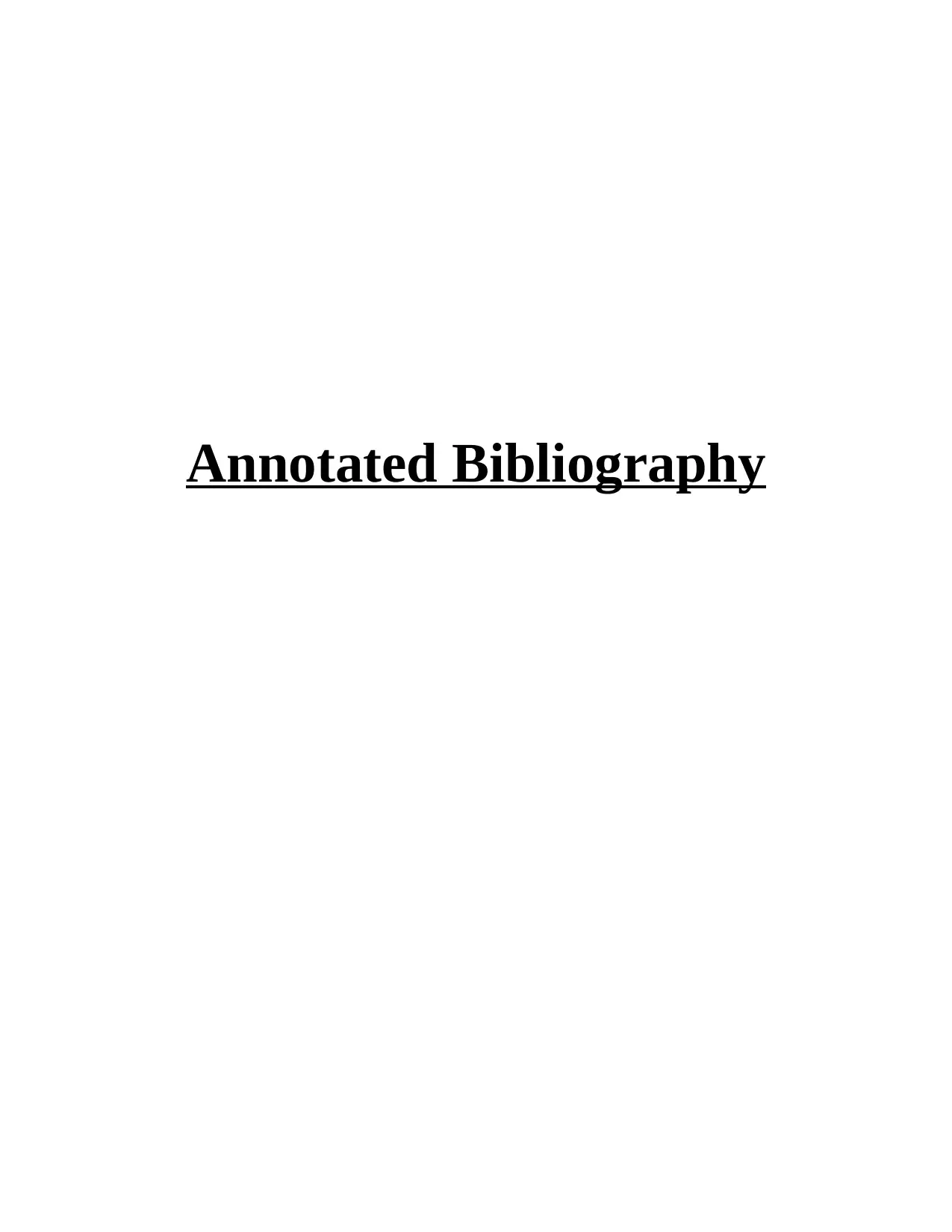
Annotated Bibliography
Paraphrase This Document
Need a fresh take? Get an instant paraphrase of this document with our AI Paraphraser
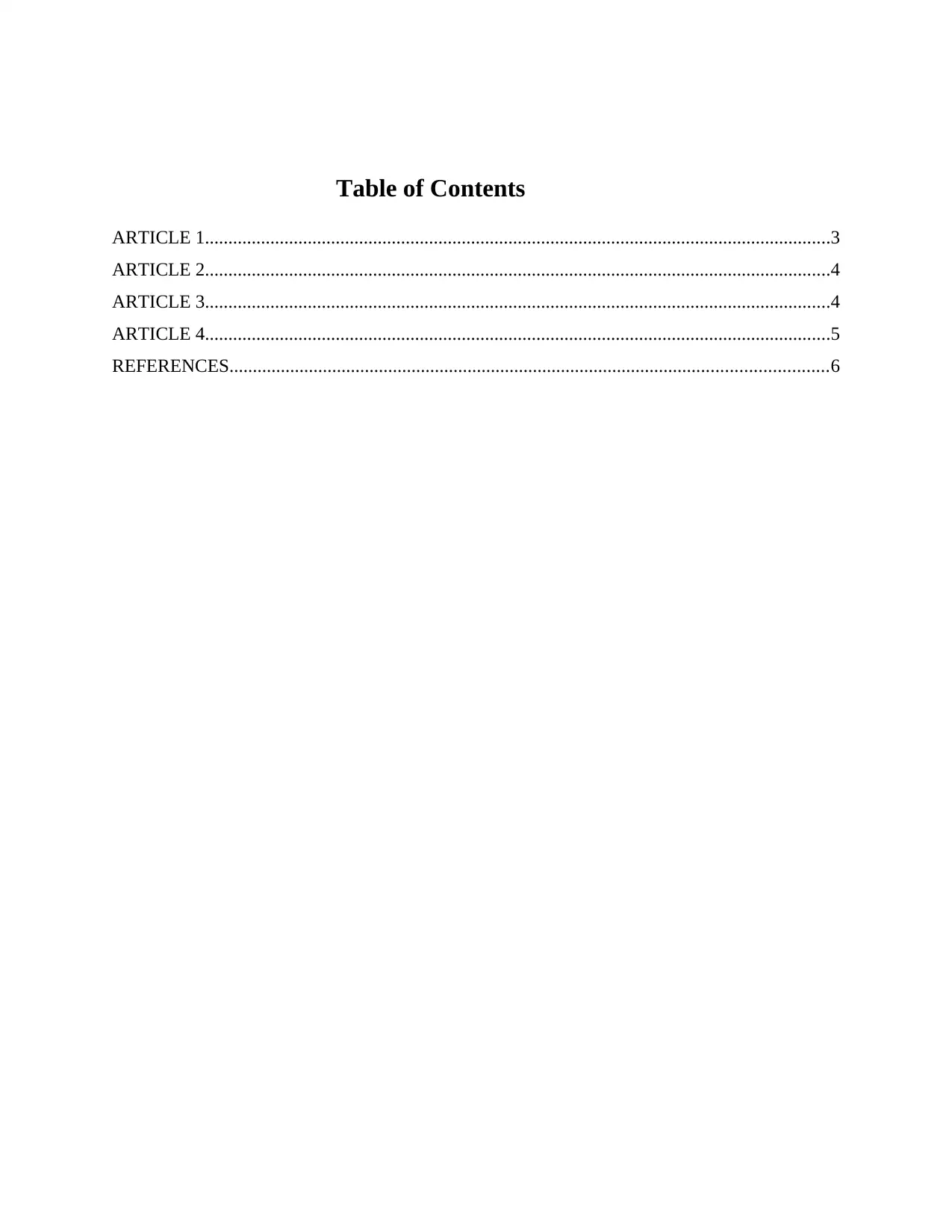
Table of Contents
ARTICLE 1......................................................................................................................................3
ARTICLE 2......................................................................................................................................4
ARTICLE 3......................................................................................................................................4
ARTICLE 4......................................................................................................................................5
REFERENCES................................................................................................................................6
ARTICLE 1......................................................................................................................................3
ARTICLE 2......................................................................................................................................4
ARTICLE 3......................................................................................................................................4
ARTICLE 4......................................................................................................................................5
REFERENCES................................................................................................................................6
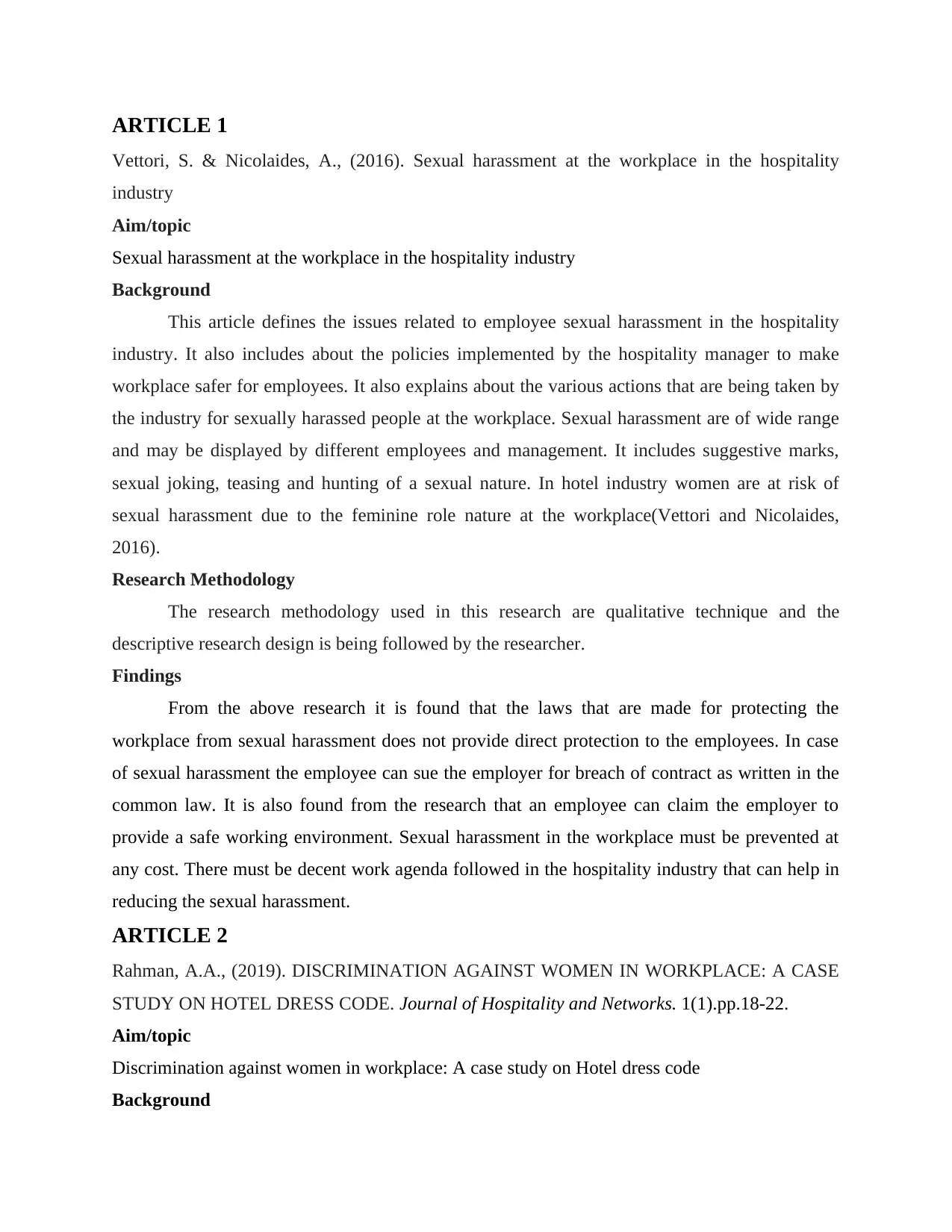
ARTICLE 1
Vettori, S. & Nicolaides, A., (2016). Sexual harassment at the workplace in the hospitality
industry
Aim/topic
Sexual harassment at the workplace in the hospitality industry
Background
This article defines the issues related to employee sexual harassment in the hospitality
industry. It also includes about the policies implemented by the hospitality manager to make
workplace safer for employees. It also explains about the various actions that are being taken by
the industry for sexually harassed people at the workplace. Sexual harassment are of wide range
and may be displayed by different employees and management. It includes suggestive marks,
sexual joking, teasing and hunting of a sexual nature. In hotel industry women are at risk of
sexual harassment due to the feminine role nature at the workplace(Vettori and Nicolaides,
2016).
Research Methodology
The research methodology used in this research are qualitative technique and the
descriptive research design is being followed by the researcher.
Findings
From the above research it is found that the laws that are made for protecting the
workplace from sexual harassment does not provide direct protection to the employees. In case
of sexual harassment the employee can sue the employer for breach of contract as written in the
common law. It is also found from the research that an employee can claim the employer to
provide a safe working environment. Sexual harassment in the workplace must be prevented at
any cost. There must be decent work agenda followed in the hospitality industry that can help in
reducing the sexual harassment.
ARTICLE 2
Rahman, A.A., (2019). DISCRIMINATION AGAINST WOMEN IN WORKPLACE: A CASE
STUDY ON HOTEL DRESS CODE. Journal of Hospitality and Networks. 1(1).pp.18-22.
Aim/topic
Discrimination against women in workplace: A case study on Hotel dress code
Background
Vettori, S. & Nicolaides, A., (2016). Sexual harassment at the workplace in the hospitality
industry
Aim/topic
Sexual harassment at the workplace in the hospitality industry
Background
This article defines the issues related to employee sexual harassment in the hospitality
industry. It also includes about the policies implemented by the hospitality manager to make
workplace safer for employees. It also explains about the various actions that are being taken by
the industry for sexually harassed people at the workplace. Sexual harassment are of wide range
and may be displayed by different employees and management. It includes suggestive marks,
sexual joking, teasing and hunting of a sexual nature. In hotel industry women are at risk of
sexual harassment due to the feminine role nature at the workplace(Vettori and Nicolaides,
2016).
Research Methodology
The research methodology used in this research are qualitative technique and the
descriptive research design is being followed by the researcher.
Findings
From the above research it is found that the laws that are made for protecting the
workplace from sexual harassment does not provide direct protection to the employees. In case
of sexual harassment the employee can sue the employer for breach of contract as written in the
common law. It is also found from the research that an employee can claim the employer to
provide a safe working environment. Sexual harassment in the workplace must be prevented at
any cost. There must be decent work agenda followed in the hospitality industry that can help in
reducing the sexual harassment.
ARTICLE 2
Rahman, A.A., (2019). DISCRIMINATION AGAINST WOMEN IN WORKPLACE: A CASE
STUDY ON HOTEL DRESS CODE. Journal of Hospitality and Networks. 1(1).pp.18-22.
Aim/topic
Discrimination against women in workplace: A case study on Hotel dress code
Background
⊘ This is a preview!⊘
Do you want full access?
Subscribe today to unlock all pages.

Trusted by 1+ million students worldwide
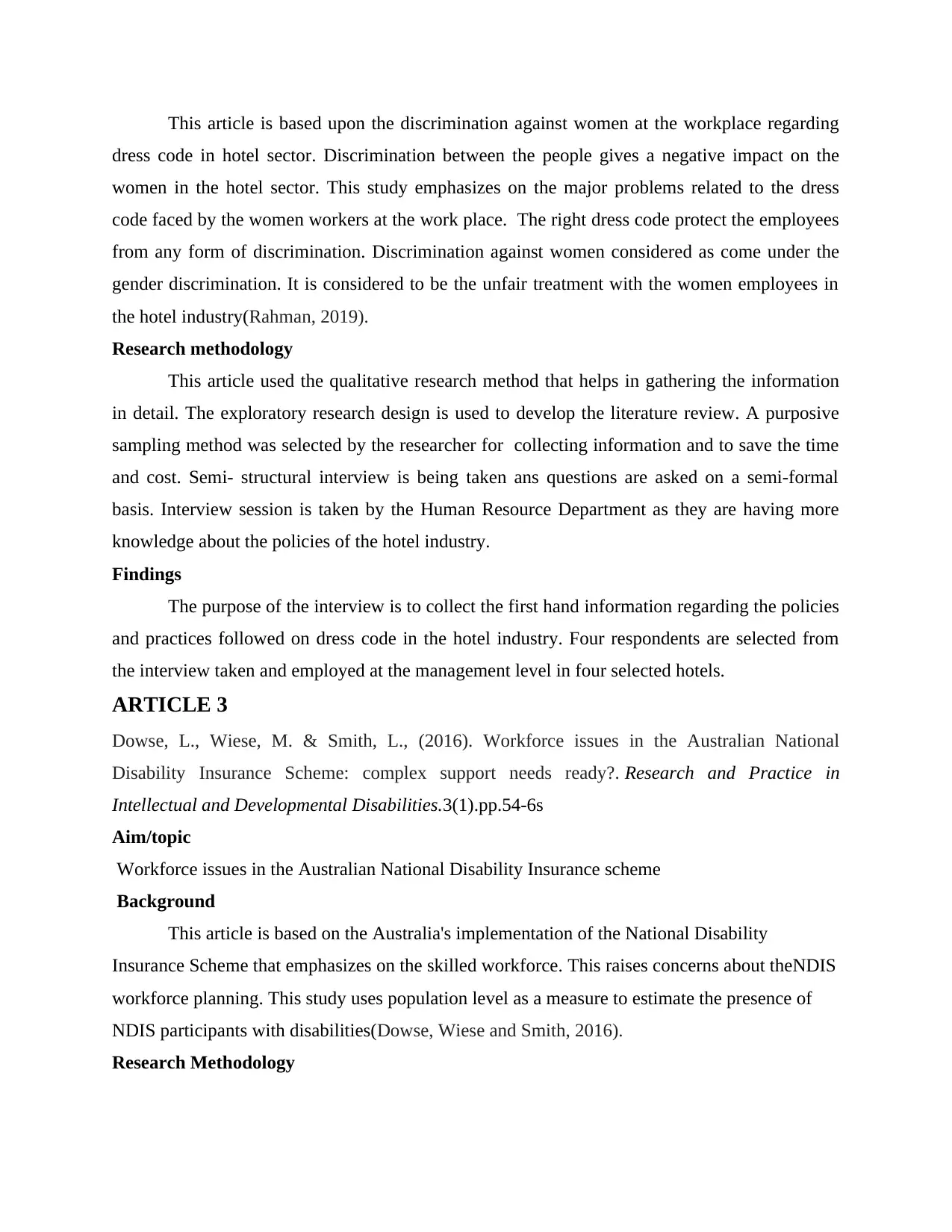
This article is based upon the discrimination against women at the workplace regarding
dress code in hotel sector. Discrimination between the people gives a negative impact on the
women in the hotel sector. This study emphasizes on the major problems related to the dress
code faced by the women workers at the work place. The right dress code protect the employees
from any form of discrimination. Discrimination against women considered as come under the
gender discrimination. It is considered to be the unfair treatment with the women employees in
the hotel industry(Rahman, 2019).
Research methodology
This article used the qualitative research method that helps in gathering the information
in detail. The exploratory research design is used to develop the literature review. A purposive
sampling method was selected by the researcher for collecting information and to save the time
and cost. Semi- structural interview is being taken ans questions are asked on a semi-formal
basis. Interview session is taken by the Human Resource Department as they are having more
knowledge about the policies of the hotel industry.
Findings
The purpose of the interview is to collect the first hand information regarding the policies
and practices followed on dress code in the hotel industry. Four respondents are selected from
the interview taken and employed at the management level in four selected hotels.
ARTICLE 3
Dowse, L., Wiese, M. & Smith, L., (2016). Workforce issues in the Australian National
Disability Insurance Scheme: complex support needs ready?. Research and Practice in
Intellectual and Developmental Disabilities.3(1).pp.54-6s
Aim/topic
Workforce issues in the Australian National Disability Insurance scheme
Background
This article is based on the Australia's implementation of the National Disability
Insurance Scheme that emphasizes on the skilled workforce. This raises concerns about theNDIS
workforce planning. This study uses population level as a measure to estimate the presence of
NDIS participants with disabilities(Dowse, Wiese and Smith, 2016).
Research Methodology
dress code in hotel sector. Discrimination between the people gives a negative impact on the
women in the hotel sector. This study emphasizes on the major problems related to the dress
code faced by the women workers at the work place. The right dress code protect the employees
from any form of discrimination. Discrimination against women considered as come under the
gender discrimination. It is considered to be the unfair treatment with the women employees in
the hotel industry(Rahman, 2019).
Research methodology
This article used the qualitative research method that helps in gathering the information
in detail. The exploratory research design is used to develop the literature review. A purposive
sampling method was selected by the researcher for collecting information and to save the time
and cost. Semi- structural interview is being taken ans questions are asked on a semi-formal
basis. Interview session is taken by the Human Resource Department as they are having more
knowledge about the policies of the hotel industry.
Findings
The purpose of the interview is to collect the first hand information regarding the policies
and practices followed on dress code in the hotel industry. Four respondents are selected from
the interview taken and employed at the management level in four selected hotels.
ARTICLE 3
Dowse, L., Wiese, M. & Smith, L., (2016). Workforce issues in the Australian National
Disability Insurance Scheme: complex support needs ready?. Research and Practice in
Intellectual and Developmental Disabilities.3(1).pp.54-6s
Aim/topic
Workforce issues in the Australian National Disability Insurance scheme
Background
This article is based on the Australia's implementation of the National Disability
Insurance Scheme that emphasizes on the skilled workforce. This raises concerns about theNDIS
workforce planning. This study uses population level as a measure to estimate the presence of
NDIS participants with disabilities(Dowse, Wiese and Smith, 2016).
Research Methodology
Paraphrase This Document
Need a fresh take? Get an instant paraphrase of this document with our AI Paraphraser
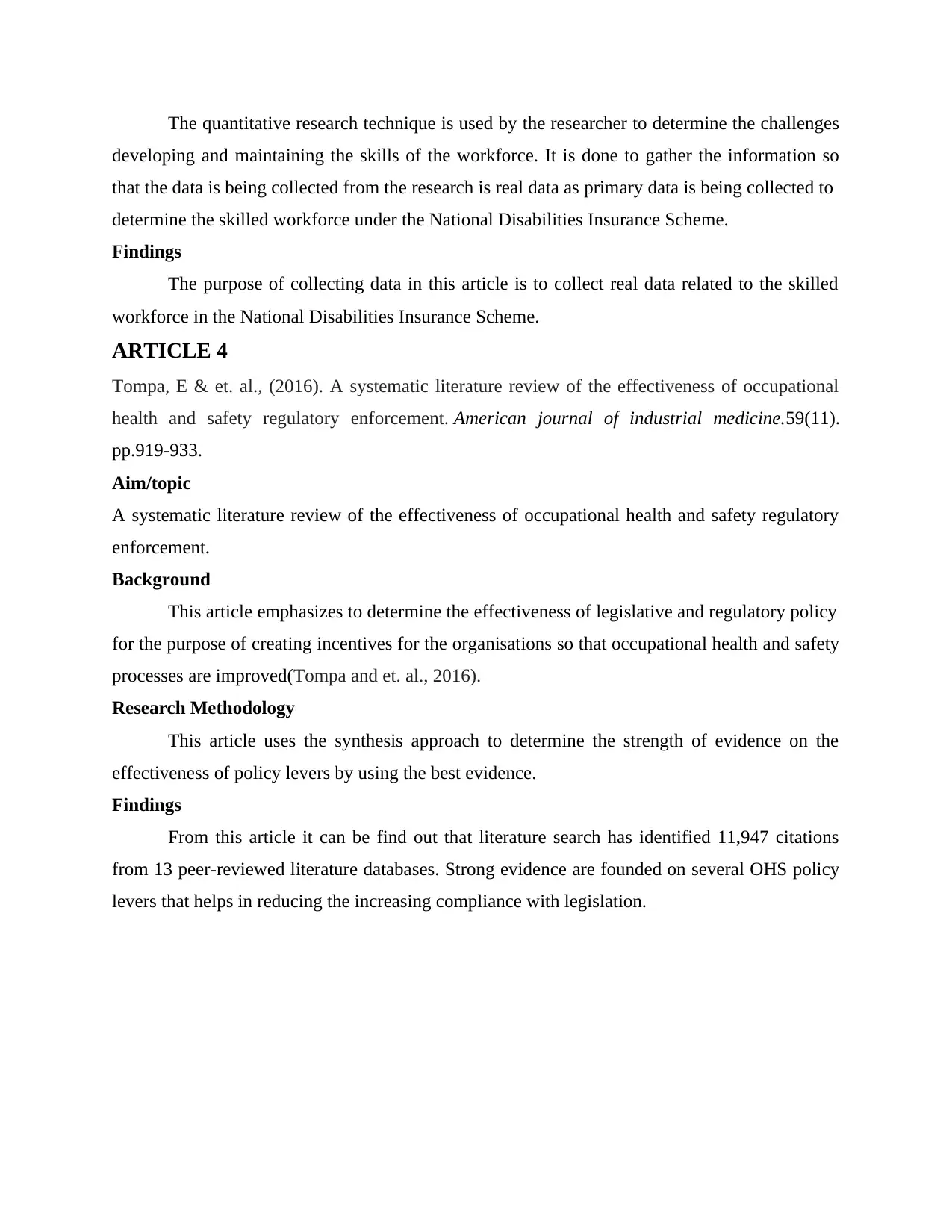
The quantitative research technique is used by the researcher to determine the challenges
developing and maintaining the skills of the workforce. It is done to gather the information so
that the data is being collected from the research is real data as primary data is being collected to
determine the skilled workforce under the National Disabilities Insurance Scheme.
Findings
The purpose of collecting data in this article is to collect real data related to the skilled
workforce in the National Disabilities Insurance Scheme.
ARTICLE 4
Tompa, E & et. al., (2016). A systematic literature review of the effectiveness of occupational
health and safety regulatory enforcement. American journal of industrial medicine.59(11).
pp.919-933.
Aim/topic
A systematic literature review of the effectiveness of occupational health and safety regulatory
enforcement.
Background
This article emphasizes to determine the effectiveness of legislative and regulatory policy
for the purpose of creating incentives for the organisations so that occupational health and safety
processes are improved(Tompa and et. al., 2016).
Research Methodology
This article uses the synthesis approach to determine the strength of evidence on the
effectiveness of policy levers by using the best evidence.
Findings
From this article it can be find out that literature search has identified 11,947 citations
from 13 peer-reviewed literature databases. Strong evidence are founded on several OHS policy
levers that helps in reducing the increasing compliance with legislation.
developing and maintaining the skills of the workforce. It is done to gather the information so
that the data is being collected from the research is real data as primary data is being collected to
determine the skilled workforce under the National Disabilities Insurance Scheme.
Findings
The purpose of collecting data in this article is to collect real data related to the skilled
workforce in the National Disabilities Insurance Scheme.
ARTICLE 4
Tompa, E & et. al., (2016). A systematic literature review of the effectiveness of occupational
health and safety regulatory enforcement. American journal of industrial medicine.59(11).
pp.919-933.
Aim/topic
A systematic literature review of the effectiveness of occupational health and safety regulatory
enforcement.
Background
This article emphasizes to determine the effectiveness of legislative and regulatory policy
for the purpose of creating incentives for the organisations so that occupational health and safety
processes are improved(Tompa and et. al., 2016).
Research Methodology
This article uses the synthesis approach to determine the strength of evidence on the
effectiveness of policy levers by using the best evidence.
Findings
From this article it can be find out that literature search has identified 11,947 citations
from 13 peer-reviewed literature databases. Strong evidence are founded on several OHS policy
levers that helps in reducing the increasing compliance with legislation.
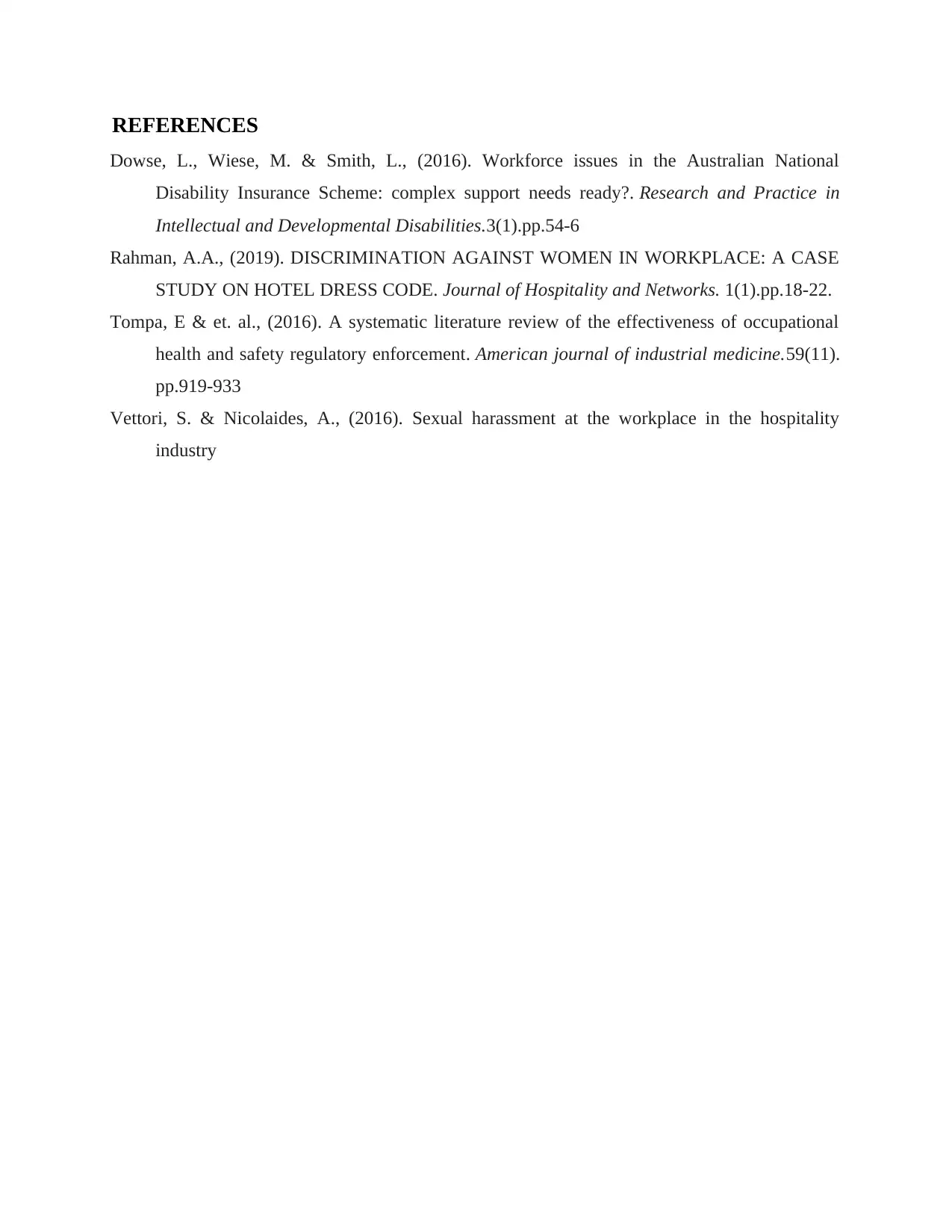
REFERENCES
Dowse, L., Wiese, M. & Smith, L., (2016). Workforce issues in the Australian National
Disability Insurance Scheme: complex support needs ready?. Research and Practice in
Intellectual and Developmental Disabilities.3(1).pp.54-6
Rahman, A.A., (2019). DISCRIMINATION AGAINST WOMEN IN WORKPLACE: A CASE
STUDY ON HOTEL DRESS CODE. Journal of Hospitality and Networks. 1(1).pp.18-22.
Tompa, E & et. al., (2016). A systematic literature review of the effectiveness of occupational
health and safety regulatory enforcement. American journal of industrial medicine.59(11).
pp.919-933
Vettori, S. & Nicolaides, A., (2016). Sexual harassment at the workplace in the hospitality
industry
Dowse, L., Wiese, M. & Smith, L., (2016). Workforce issues in the Australian National
Disability Insurance Scheme: complex support needs ready?. Research and Practice in
Intellectual and Developmental Disabilities.3(1).pp.54-6
Rahman, A.A., (2019). DISCRIMINATION AGAINST WOMEN IN WORKPLACE: A CASE
STUDY ON HOTEL DRESS CODE. Journal of Hospitality and Networks. 1(1).pp.18-22.
Tompa, E & et. al., (2016). A systematic literature review of the effectiveness of occupational
health and safety regulatory enforcement. American journal of industrial medicine.59(11).
pp.919-933
Vettori, S. & Nicolaides, A., (2016). Sexual harassment at the workplace in the hospitality
industry
⊘ This is a preview!⊘
Do you want full access?
Subscribe today to unlock all pages.

Trusted by 1+ million students worldwide
1 out of 6
Related Documents
Your All-in-One AI-Powered Toolkit for Academic Success.
+13062052269
info@desklib.com
Available 24*7 on WhatsApp / Email
![[object Object]](/_next/static/media/star-bottom.7253800d.svg)
Unlock your academic potential
Copyright © 2020–2025 A2Z Services. All Rights Reserved. Developed and managed by ZUCOL.




